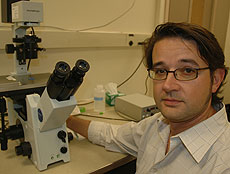February 12, 2007
Physicists tackling new challenges in neurobiology
By
Brittany Grayson
UCSC physicists are using technology and expertise gleaned from the field of high-energy physics to address challenging problems in neurobiology.
 Postdoctoral researcher Alexander Sher received a career award from the Burroughs Wellcome Fund to support his research on neural networks in the retina.
Postdoctoral researcher Alexander Sher received a career award from the Burroughs Wellcome Fund to support his research on neural networks in the retina.
Photo: Tim Stephens
|
With support from the National Institutes of Health and the Burroughs Wellcome Fund, they are developing new tools to investigate the activity of living neural networks and building interdisciplinary partnerships with neuroscientists.
Alan Litke, an adjunct professor of physics at UCSC, has been conducting research at the intersection of physics and biology for over a decade. In 2006, he received a $395,000 NIH grant to develop new technology for studying neural networks in brain tissue. Alexander Sher, a postdoctoral researcher in Litke's lab, has just received a $500,000 career award from the Burroughs Wellcome Fund to support his research on neural networks in the retina. Both projects use arrays of microscopic electrodes to probe the activity of large numbers of neurons simultaneously.
Sher's award from Burroughs Wellcome Fund's Scientific Interface program is intended to encourage and reward interdisciplinary research by helping researchers with backgrounds in the physical and computational sciences apply their skills to research in biology. That's exactly what Sher, who spent 15 years studying high-energy physics, is doing.
"All the training I've had up until now, through all my undergraduate and graduate career, was really in physics, and now I'm switching to neurobiology," Sher said. "It's a difficult transition. This grant makes it much, much easier."
Litke still conducts research in both worlds. He studies high-energy particle physics at CERN in Geneva, Switzerland, and is affiliated with the Santa Cruz Institute for Particle Physics (SCIPP) at UCSC. Meanwhile, he is collaborating on neurobiological research with neuroscientists at UCSC and other institutions.
"The award from the Burroughs Wellcome Fund is designed to support interdisciplinary work, and it really validates what we're doing in Santa Cruz," Litke said.
Until recently, his experiments took place in the laboratories of collaborators at other institutions, using microelectrode arrays and other instruments that Litke's group at SCIPP developed. Now, however, Litke has begun conducting some experiments in the UCSC laboratory of David Feldheim, an assistant professor of molecular, cell, and developmental biology who studies retinal and neural development in mice. In addition, the Division of Physical and Biological Sciences has provided laboratory space and seed money for Litke and Feldheim to establish an interdisciplinary neurophysiology lab on campus.
"Once we get the facility up and running, it will attract neuroscientists from all around the Bay Area to come here to use this technology?]?]that's how special it is," Feldheim said.
Most of Litke's previous work on neural networks has focused on the retina, a thin layer of tissue on the back wall of the eye. The retina converts light into electrical signals, processes those signals, and sends the output to the brain via the optic nerve. Sher is currently using the microelectrode array to record signals from retinal neurons in an effort to understand color vision.
"I record the output of the retina while showing different color stimuli to the receptors. That lets me start to understand what's going on," Sher said.
Sher places a slice of living retinal tissue on top of an array of microelectrodes in a special chamber that can keep the tissue alive for several hours. He focuses flickering images on the photoreceptors while the microelectrode array monitors the retinal neurons' responses.
With his new NIH grant, Litke uses a similar system to study neural networks in brain tissue from rats and mice. He has increased the size of the microelectrode array from 60 to 512 electrodes. He is also modifying the instrument so that it will not only record signals from the neurons, but will also stimulate them with electrical signals, just as images were used to stimulate the retinal cells.
These studies could help reveal how neurons process, store, and recall information. According to Litke, neuroscientists have traditionally studied one neuron or a very small group of neurons. But understanding how the brain works will require studying how systems of neurons work together.
"Thinking is presumably not based on what a single neuron is doing, but on the firing patterns of many, many neurons," Litke explained.
Networks of neurons in the brain are able to recognize patterns, store information, and recall it when it's needed. Litke said he is excited about the possibility of studying these phenomena in a controlled way using the new microelectrode array.
"We will be able to send in a pattern of information through the electrodes and then record the response of this living neural network to see how it responds," Litke said. "Can we store the pattern inside this piece of living, neural tissue? If we keep sending the same pattern, maybe it will begin to play that pattern spontaneously."
Simply being able to record neural activity in a slice of brain tissue or a layer of brain cells grown in a Petri dish is in itself a remarkable thing, Litke said.
"It's fascinating that all this is happening in a little squirmy piece of stuff only a few hundred microns thick," Litke said.
Litke's collaborators on the NIH grant, in addition to Sher, include John Beggs at the Biocomplexity Institute at Indiana University; Wladyslaw Dabrowski at AGH University of Science and Technology in Krakow, Poland; and SCIPP researchers Alex Grillo, Pawel Hottowy, and Serguei Kachiguine. The retinal experiments are performed in close collaboration with E. J. Chichilnisky at the Salk Institute for Biological Studies.
The Burroughs Wellcome Fund is an independent private foundation dedicated to advancing the biomedical sciences.